Prof,
Just a quick email to let you know we don’t want any reports on San Diego. The 2HG format is largely irrelevant now.
Craig S.
Okay, so can I just show my holiday snaps instead?
…
You sure that will be okay? I mean, I know how the forum whiners like to moan about lack of content and all that. I don’t want anyone junking their premium membership or anything. You know how messy it gets when you send me out to ask them to reconsider.
…
What’s that? Yeah it’s fine, go ahead? Really?
…
Excellent. I’ll just go and set up the projector. You stay right there.
Mfph-fgle!
Oh, right… I guess you aren’t going anywhere just now. Those ropes aren’t too tight, are they…?
…
…
I know that the rest of you out there aren’t tied to a chair in a hidden concrete bunker. You might be thinking, “nah, no need to read this.” Indeed, your finger might be twitching the cursor right towards the back button right now.
But just before you do, allow me to introduce you to my associate Mr Rhino…
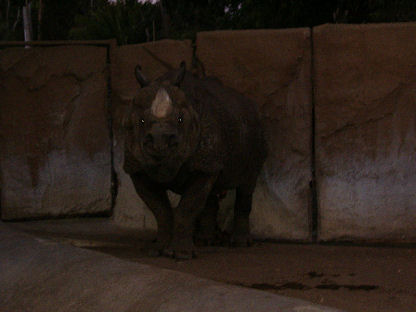
Mr Rhino knows everything. He knows where you live, and he’s watching you right now. If you don’t read this article right the way to the end, then Mr Rhino will know and he will be unhappy.
You don’t want to make Mr Rhino unhappy.
Not unless you want to end up like a villain in a Carl Hiassen novel.
Can we say “squished” … ?
The weekend before last (or, rather, last weekend as I write this) I completed the second leg of my North American Magical tour with a trip to sunny San Diego in order to compete in Pro Tour: San Diego 2007. The tournament was being held here:

… at the San Diego convention center. It was very sunny. I got sunburnt and went a very fetching shade of lobster red, as can be seen in my live player blog here.
As I correctly predicted last week, I showed up got my two points and really didn’t do a lot else. I didn’t really have high hopes. Team formats, especially team Limited formats, just aren’t my thing.
Although when I anticipate not doing well, it’s usually in the mediocre 2-4, 3-3 sense, rather than the full-blown, “how about we kick you while you’re down, stamp on your bollocks, and drop your favorite kitten in a pan of boiling oil for good measure” 0-5 sense.
Ouch.
I suppose at least I got some rotten luck out of the way in a format I was unlikely to perform well at in any case. The ironic thing is I’d actually done quite a few practise drafts beforehand, and was 7-0 versus the English and Irish teams.
However, I’d also noticed our draws had been a little on the benevolent side, and I was probably overdue a screw at some point. Unfortunately, variance reared its ugly head in the main event, as in two of the five games either Fizz or I failed to lay a third land.
The first draft was one of those tricky ones where the overall power level of the cards is fairly low. If you’re not very experienced it’s easy to follow a couple of Drafting With Rich articles, make the exact same picks, and wonder what the challenge is about this drafting game. However, there are also those drafts when it really isn’t clear what’s going on. The reason Rich Hoaen is so much better than you and I is because he finds a way out of the train wreck… while everybody else gets buried under tons of twisted metal.
The first draft wasn’t exactly a train wreck, but it was very light on removal and discard, two things I prize highly in 2HG. I thought our decks were weak, but maybe okay if the overall pool was fairly weak. Unfortunately, the scarcity of removal meant Big Oots rebel chain with two Rathi Trappers dominated us in the first game, and a screw on Fizz coupled with a backbreaking Rough in the second round left us 0-2.
I thought our second decks were pretty good, but we were put under too much pressure early on in both games and couldn’t quite stabilize. Even with fewer cards, this was still a format where you wanted to go first.
The last draft was hilarious and made up for the disappointment of the day. We were a three-team pod on the second to last table that also included the strong Japanese team of Ryuichi Arita and Kazuya Mitamura (finalist at PT: Yokohama a few months back). At 0-4, there’s no point taking things seriously. You may as well have some fun.
Well, when we couldn’t actually hear the draft announcements the table just decided to “go for it” at our own pace. It was a very silly draft with cards being taken at random. Of course we were being too silly and eventually drew the attention of chief zebra Toby Eliott to keep an eye on our “rogue” table.
The judging team handled it pretty well, to be fair. They could see we were already eliminated and just having fun, but the Pro Tour is the Pro Tour, and as players we have a duty to at least look professional, even if we’re too rubbish to even scrape a single win by round 5.
So that meant no, Arita couldn’t play on his DS while we waited for everyone else to catch up (we’d finished drafting the first Planar Chaos booster before the first Time Spiral booster had finished).
It was a lot of fun, and the only disappointment was that our forty card decks completely crapped out and we couldn’t even give Arita and Mitamura’s 60 card decks (“Constructed masters, we play 60 cards” as Arita joked — I love the Japanese attitude to the game) a decent game after I got mana screwed and Fizz drew a lot of Whitemane Lions and Stonecloakers after her creatures had already been killed.
San Diego is an odd place. When I was here last, it was for the Odyssey Rochester draft Pro Tour back in 2002. That tournament was a heartbreaker, as I started out 3-1 and then got killed by some truly horrible boosters in the second draft. For that tournament we were staying at a cheap motel out by the airport, and San Diego felt like a ghost town. No matter which direction we picked, it seemed like we had to walk miles just to find anything.
This time the nice Irish couple of Brian Kidney and Antoinette (hope I’ve spelled that correctly) had booked a pleasant apartment in the Gaslamp quarter, and put up most of the Brits. While the area was certainly livelier, I’m not sure I really liked it. The restaurants seemed a little crowded and over-priced. I normally like a quiet drink or seven, and the main street just seemed a little… well, pretentious.
5 Songs I scared people with back at the apartment:
1. Five Pointe O — “Untitled.”
2. Fear Factory — “Resurrection.”
3. Nightwish — “Wish I had an Angel.”
4. Cult of Luna — “Circle.”
5. Nile — “Ramses, Bringer of War.”
Anyway, time for some more holiday snaps just to prove that you can do more at PTs than just play Magic. Hey, don’t frown. When someone asks what you did at San Diego, you can steal these photos and pretend you went to the zoo instead of three-on-three drafting all weekend.
We actually walked to the zoo from the convention centre. This involved an epic trek across the centre of San Diego, where we were accosted by deadly suicidal squirrels in the park:

Just after taking this picture, the squirrel called in its mates for a rumble. It was looking tricky for a while, but then I was able to uproot a road sign and batter them into bloody smears. Strength of numbers matters little against sheer unrivalled squirrelcidal psychosis.
I knew the zoo was somewhere in the north region of the park, but wasn’t quite sure. As a result, we randomly paid a visit to the Museum of Man.

Once there, I sacrificed a live virgin (we found someone wearing their Pro Tour T-shirt) to eldritch dark gods in order to stay on the train for next year (live puppies don’t appear to be cutting it anymore).
For anyone that ever wondered what happened to John Ormerod….
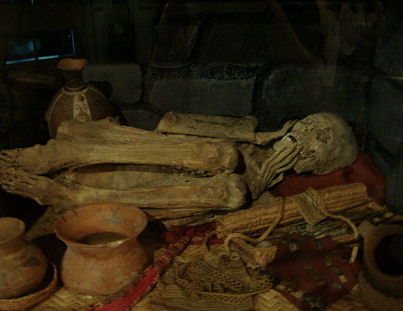
Bwahahahahahaha!
But enough prehistoric prankery. The true goal of our epic quest was the zoo, and after several blocks too far to the north, a revitalising Jamba Juice (and crippling brain freeze), and short taxi ride to the other side of the park later, we achieved our objective:
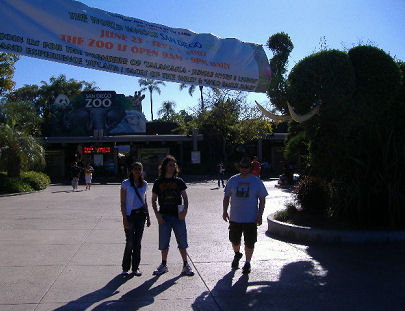
… and I took some pictures.
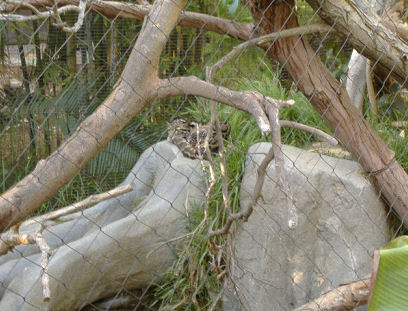
It’s a cat. It’s asleep.
Because, as any cat owner knows, this is what cats do for 90% of their time. The other 10% of the time is spent pestering you for food, or ripping apart small furry things and bringing the remains back to you with a pleased expression. Lions and leopards are just the same, apart from it being a little more awkward when they come back with little Johnny hanging from their mouth.
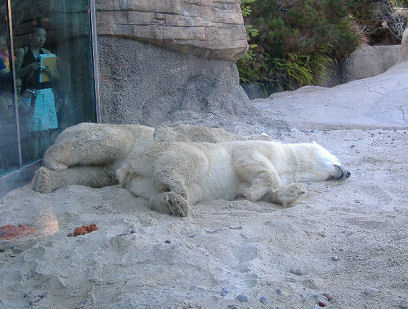
It’s a bear. It’s asleep.
They’re kind of like cats, except they bring back larger things. Like small trucks.
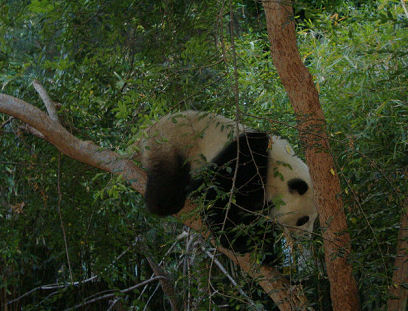
It’s a panda. It’s a… complete f***ing nutter.
I don’t know about you, but I used to think pandas were comedy animals that spent most of the day lolling about eating bamboo. I kind of expected to see a sort of giant black and white badger sitting around eating bamboo and feeling sorry for itself because it couldn’t get it up.
The last thing I expected was crazy Yoda-style acrobatics through the trees. I don’t know what they put in the bamboo, but I want some too. (I may have made up most of the stuff in this article, but this is actually true. While we were there, the panda looked to be having a whale of a time, charging around like a mad thing.)
I was trying to work out what it was doing, when it suddenly bent the branch down far enough to catapult itself into the crowd. That was fairly cool, apart from that icky bit when it ate the two-year-old kid.
Didn’t hear about it?
The zoo probably hushed it up.
(Okay, so I may have made that up.)
The panda was fairly cool, but for me the highlight was the hippo:
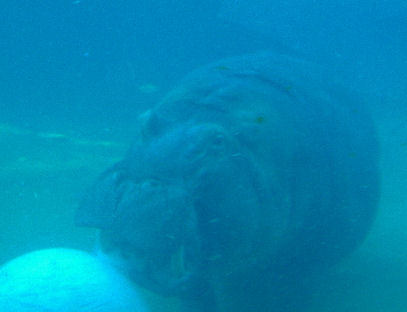
He was really enjoying himself pushing a concrete ball along the bottom of his enclosure:
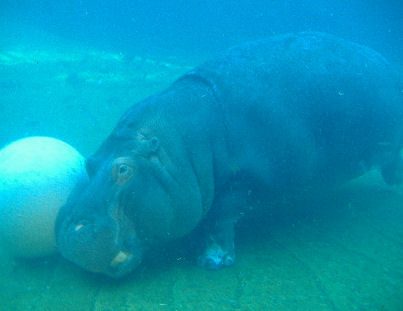
I reckon we should sign him for the England football (the s-word I can’t bring myself to say for our U.S. chums) team. I don’t care how tight the German defence is, they ain’t keeping out Jabba. He’s two and a half tonnes for a start.
Of course, being a zoo we also had elephants:
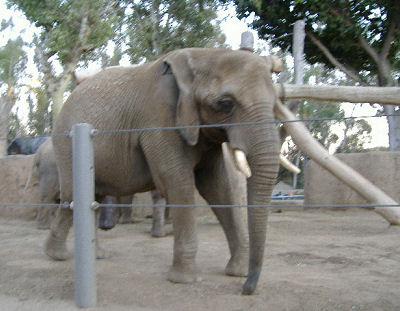
… and zebras…
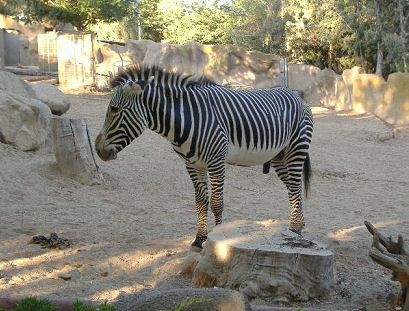
I think someone just asked him what happens if both Urborg, Tomb of Yawgmoth and Blood Moon are in play.
… and… uh… ducks…
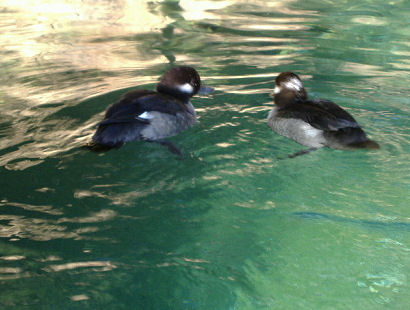
Hoi-Sin sauce, anyone…?
There was also a very scary pair of Hyenas.
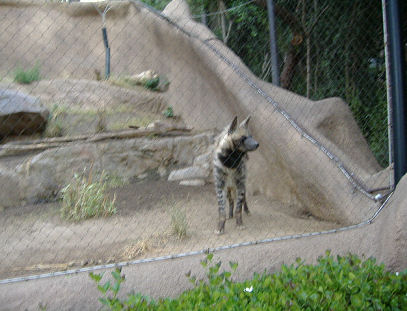
I don’t normally like seeing predators at zoos, mainly because if you take an animal with a usual range of many kilometres and put it in a small cage it begins to exhibit stereotypical behavior, such as pacing back and forth. I remember walking around a zoo a few years back and being saddened at looking into the dead eyes of leopards and cheetahs as they walked back and forth. Sure, they were alive and still moving, but look into their eyes and there’s nothing there.
Sometimes I feel like that too.
Anyway, the hyenas were slightly different. Out in the wild, hyenas are pack hunters, and while they aren’t as big as lions, they are very effective at picking off the young and infirm. While I was taking this picture, there was a very small child taking a few tottering steps outside of its stroller. Exactly the kind of vulnerable prey a hyena would go after in the wild. As soon as it saw the child, the hyena was completely fixated.
That hyena really wanted to eat that child.
I told the kid this, and then told him that, once “locked” onto you as prey, a hyena can track you down anywhere and will never give up until it gets its jaws around your juicy bones. I also told him that Hyenas are really smart and escape from zoos all the time. (It helped that the second was off picture digging a big hole.)
Pleasant dreams. Hyuk, hyuk.
(Again, I may be making this up, although telling tall tales to terrify young children is always a pleasing endeavor.)
Spotted Hyenas have weird social organisations. Anyone who’s studied biology/zoology at the undergraduate level will have probably been given lectures on it at some point. I can’t really go into it in too much detail on a family friendly website, apart from saying that it’s a novel twist on chicks with… uh… extra pieces of anatomy (And no, I’m not making this up either).
And don’t forget Mr Rhino:

Now is there anything I’ve forgotten…
Content!
Oh yeah. I suppose I should talk about something Magic-related.
In case you’re unaware, Pro Tour: San Diego was won by this pair:
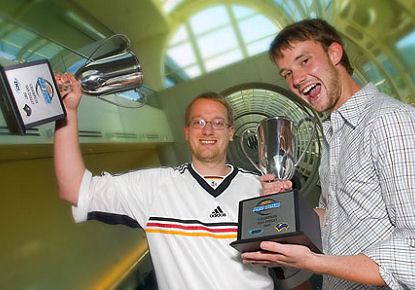
… and thanks in part to this card:
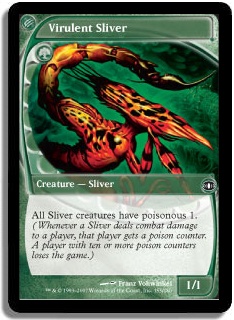
2HG has received an almighty bashing from the playing community. While it’s very popular amongst pre-release players, it gets a lot less popular very quickly amongst more competitive players. The majority of the pros really hate it, citing the randomness of best-of-one as the chief point of contention.
Given that the Top 8 featured two unknown Japanese teams and an unknown U.S. team, it would be very easy to take this as evidence of how random the format is. Chris Lachmann and Jacob Van Lunen were just a pair of amateurs that got lucky with Slivers. May as well call them Luckman and Van Lucken, I bet some people thought.
I don’t think this would be anywhere near the full story, however. Lachmann and Van Lunen were the story from San Diego because they’d come up with a good strategy, implemented it perfectly, and took it all the way to a Pro Tour title. They put in the work to test the format and it bore dividends, just like Mike Hron’s ridiculous amount of practise drafts before PT: Geneva.
I’m not going to go into the finer details of drafting Slivers in 2HG because, as my editor has pointed out, 2HG with Time Spiral is utterly dead and of no interest to anyone.
However, there are some very important lessons that can be gleaned from Lachmann and Van Lunen’s success that can be applied to Magic in general. And, as Aaron Forsythe pointed out last Friday, 2HG isn’t going anywhere anytime soon. Nationals are coming up and anyone making their national team will be playing 2HG at the World Championships in New York later this year. There will also be another 2HG Pro Tour next year, although if they take my beloved Block format away again like they did with Ravnica I’ll personally wire Gleemax up to 10 billion volts and fricassee its grey matter.
Anyway, back to Lachmann and Van Lunen and the interesting question:
Once people realised how powerful the Sliver strategy was, why did no one stop them?
And when we start to look at that, another question presents itself:
How much of a role did the official event coverage play in propelling Lachmann and Van Lunen to victory?
By the way, I’m not assigning any sinister motives here. I’m just thinking it might be an interesting point to consider.
To most players at home, the thought that everyone knowing your strategy in advance could be a benefit sounds intensely counter-intuitive. Magic is a game of hidden information, after all. You want to keep secrets, as secrets mean you get to catch your opponent unawares.
Yet pretty much everyone knew Lachmann and Van Lunen were going to draft Slivers on that final table. They knew it, their opponents knew it, everyone in the room knew it.
And yet they still got the deck despite three teams knowing exactly what they were planning to do.
Why didn’t the three teams completely mug them and cut off the slivers?
Some of you at home might be thinking.
Or:
Pro Tour Winners, huh. If they’d been drafting around our house we’d have taken all their slivers and battered them to death.
Again, this is another one of those strategies that really only pays off so long as you can rely on everyone else behaving rationally. Fortunately it’s the Pro Tour, so (most of the time!) you can take that as a given.
There is a very good reason why Lachmann and Van Lunen were successful, and once again we go back to our old friend Game Theory (and then watch me get tied up in knots, as I’m by no means an expert on the field).
About a month back, Frank Karsten wrote an excellent article on the application of Game Theory in Magic.
One of the examples referred to drafting Slivers in 2HG. While Slivers did indeed go on to win the Pro Tour, in this case I think Karsten is using them as an abstract example of a risky strategy that dominates if left unchecked, but can backfire if you end up competing with another team for the same strategy. Karsten compared it to the classic Prisoner’s Dilemma problem. The best overall strategy is for the two teams to co-operate and leave the slivers alone… however, the best individual strategy is to defect, or rather take the slivers. Because of this, both teams will try and force slivers, even though it results in both teams getting an overall worse score than had they co-operated.
This, of course, assumes that slivers is the best strategy if taken unopposed. Before San Diego of course, many of the pros were less than convinced on this.
So now we’re back to the final draft, and things are a little different. There is one team (A) in the Top 4 that is unequivocally definitely going to take slivers. As one of the three remaining teams (B), you have three options:
1. Take slivers.
2. Hate slivers.
3. Ignore slivers.
Your first goal is to win the next round, and your second goal is to win the round after that (the final).
Option 1 is pretty bad. We already know A is going to draft slivers, and we know that splitting the slivers would mean that both of you end up with bad decks. In this scenario the match against A becomes a coinflip, and you probably lose to C and D unless they chose to draft slivers also.
Option 2 is the best overall option for teams B, C, and D, as it stops A from assembling the sliver juggernaut. In simple terms, B, C, and D have favorable matches against A and even matches against each other.
If we left it there, then it would be fairly straightforward.
However, there is a capacity to cheat here, which is where option 3 comes in. If you just ignore slivers and draft normally, then you’re going to get an advantage over anyone who hates slivers while still getting the same benefit of beating up a crippled sliver deck. The downside, of course, is if everyone decides to cheat, then you all get beaten up by the unchallenged sliver deck.
And, of course, everyone tries to cheat for fairly obvious reasons. Each of the three teams is trying to maximise their own personal success. Wasting picks just to stop A means you just get beaten up by C and D.
This puts the sliver deck in a fairly unassailable position. One of the other teams could go after them, but all it would achieve is to knock both of them out while the other two teams carved up the spoils.
Coincidentally, this is also why it is usually a good idea to draft cooperatively and not hate-pick in normal drafts, even though it bites to pass that Damnation when there’s no way you can play it.
This is where the Observer Effect (I was going to talk about Heisenberg Uncertainty Principle, but Wikipedia informs me this is a common misconception so I’m going to hope it’s right) of coverage comes in. Event coverage is important. It generates interest, which sells boosters, which allows the game to continue as an ongoing financial concern. Ideally, coverage should be invisible to the competitors and just report on what’s happening. However, it is inevitable that the act of observing, or writing, on an event is going to effect the event itself.
The obvious one used to be deck lists. Someone with a fancy deck would get featured, and then find themselves at a massive disadvantage against anyone who’d read the coverage for the remainder of the tournament. At PT: LA in 2005, when I went 8-0 on Day 1 with the Grave-Troll deck, I found myself playing against Jeff Novekoff for the first round of the morning when I had no idea of what he was playing, while he’d had the whole of the evening before to prepare.
Now let’s go back to Lachmann and Van Lunen. The worst thing that could probably happen for their strategy was if they ended up sitting at a table with another team that also forced Slivers as strongly. With four teams running hidden strategies, it is quite possible for two teams to independently have the same strategy. This is bad for both of them.
However, when you have one public sliver strategy and three hidden strategies, it’s really good for the guys with the public sliver strategy.
Basically they can say, “We don’t what you guys are doing, but we’re going for slivers. You can fight if you like, but that will just hose both of us.”
Once Lachmann and Van Lunen had generated as much interest in their strategy as they had, they entered the final table from a position where pulling off their strategy was an inevitability.
It might have been more interesting if one of the other teams, say Harvey and Fiorillo, had come to the final table with the exact same public strategy.
Now we have two teams with the same public strategy. Both teams would know that if they both went for the same strategy then it would probably kill both of them. However, the difference with both of the strategies being public is that they’d both also know that they’d kill each other if they stuck to it. Now there would be an element of doubt and risk leading to basically a game of chicken.
We already know what the result of this would be, as we’re back to the classic Prisoner’s Dilemma as outlined in Karsten’s article. Both teams would end up crashing into each other while forcing the strategy, even though backing off would guarantee better overall results for both of them.
This raises some interesting points about coverage. I have abstracted the problem to extremes, obviously. It would be foolish to say highlighting Lachmann and Van Lunen’s sliver strategy when they were unbeaten on 6-0 “gave” them the Pro Tour, as there are just too many other factors to consider. As someone who’s worked on coverage frequently in the past, it’s definitely an interesting issue to consider.
Running a public draft strategy has been tried before, most notably Zvi Mowshowitz’s “White hint-hint” shirt from a few years back. I don’t know what’s in Lorwyn, but I’ve heard rumors there might be a tribal theme. Will players be turning up to 2HG day at Worlds with “hint-hint Elf” shirts, I wonder?
As for 2HG, I still think it’s going through a teething phase. I don’t like how cards behave differently, but I know people in R & D are looking to address this problem in future sets. This was done in the past to make Magic more conducive to draft, so there’s no reason this problem can be overcome.
The biggest problem as I see it is the best-of-one issue. While I R & D would have been fine with the sliver wins, the other semi-final where Fiorillo got stuck on two land would have been their worst nightmare about the format realised. I’m not sure how the problem can be solved. Best of three is too time consuming, and although Aaron Forsythe has a point about players skimping on lands (I played 18 land in most of my decks), that still isn’t a guarantee against a poor draw. I don’t think going back to 40 life helps. Then we’re stuck in the uber-greedy mode of before, where no one plays anything before a dragon on turn 6.
The only possibility I can think of is fairly radical.
Let people start with more cards.
The “free” mulligan is never actually free. If your second hand of seven is horrible, then you can’t exactly go back to the first hand.
I would do away with it entirely, and maybe look at increasing the hand size to maybe start with something like nine cards. It’s an off-the-top-of my head thought that might be impossible to implement in practise, but it should at least give players a smoother beginning to the game and reduce the number of one-sided blowouts because a player didn’t draw the land they needed in the first four draw steps.
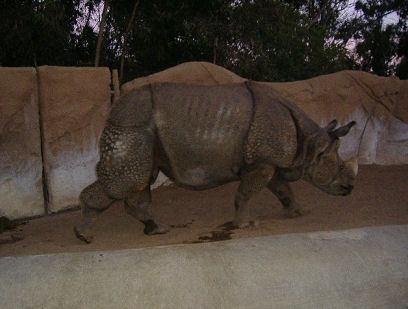
Mr Rhino is happy.
You may leave.
Thanks for reading,
Prof

